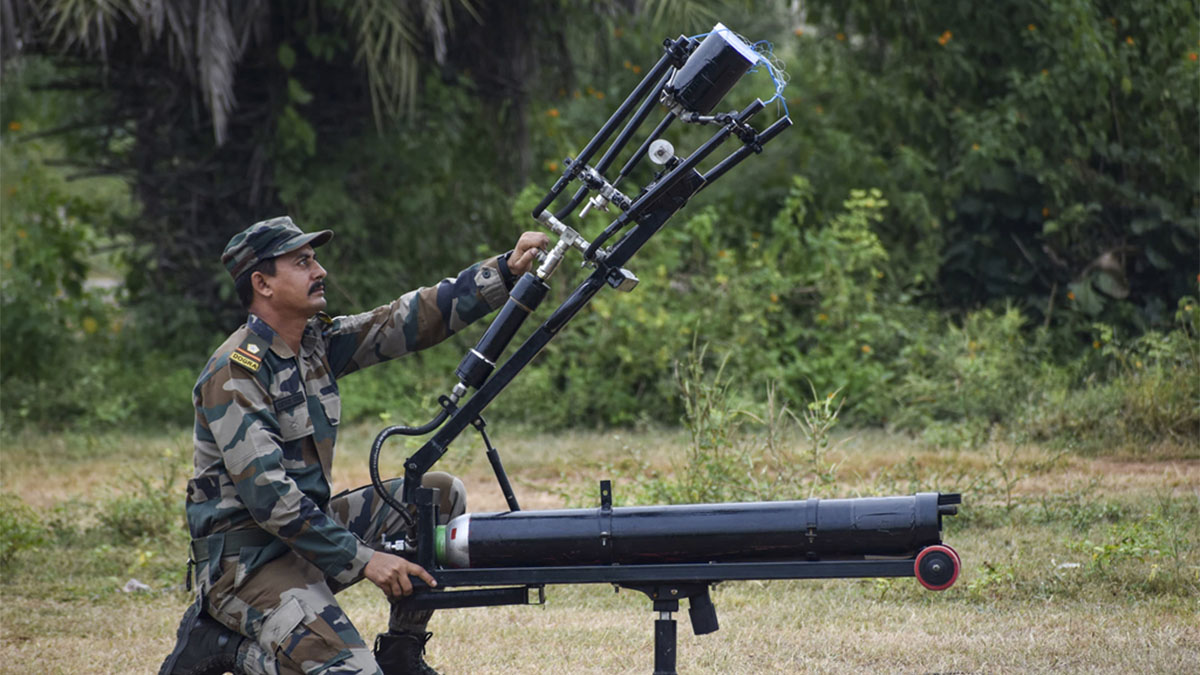India’s Defence Research and Development Organisation (DRDO) on Sunday, April 13, 2025, announced the successful trial of the in-house developed Mk-II(A) Laser-Directed Energy Weapon (DEW) system. It thus demonstrated having mastered the technology for disabling missiles, drones and smaller projectiles. The success has put India in the exclusive and limited club of nations, which possess the high-power Laser-DEW systems.
The trial was carried at the National Open Air Range, Kurnool in Andhra Pradesh. “Indigenously designed and developed Mk-II(A) DEW system was demonstrated in its entire spectrum of capability by engaging the fixed wing drones at long range, thwarting a multiple drone attack and destroying enemy surveillance sensors and antennae,” the DRDO statement said. “The lightning speed of engagement, the precision and the lethality delivered at the target within a few seconds made it the most potent counter drone system.”
DEWs are considered a cost-effective defence against low-cost drone attacks. DRDO press release further added, “Cost of firing it for few seconds is equivalent to the cost of couple of litres of petrol. Therefore, it has the potential to be a long-term and low-cost alternative to defeat the target.” The system was developed by DRDO’s Hyderabad-based Centre for High Energy Systems and Sciences (CHESS), along with other labs, academic institutions and Indian industries.
Once detected by a radar or by its inbuilt Electro Optic (EO) system, laser-DEW can engage targets at the speed of light and use an intense laser beam to cut through the target, burning its electro-optical sensors, causing structural failure or exploding its warhead. This type of cutting-edge weaponry has the potential to revolutionise the battle-space by reducing the reliance on expensive logistics-dependent ammunition. It could also lower the risk of collateral damage.
The proliferation of unmanned aerial systems (UAS) and the emergence of drone swarms as asymmetric threats are driving the demand for DEWs as counter-UAS and counter-swarm capabilities. The DEW would soon be replacing traditional kinetic weapons and missile defence systems due to its ease of operation and cost effectiveness.
What is a DEW and its operational advantages?
A DEW is a ranged weapon that damages its target with highly focused energy. It has no solid projectile. It includes lasers, microwaves, particle beams, and sound beams. Potential applications of this technology include weapons that target personnel, missiles, vehicles, satellites, and optical devices. Many defence labs in the US’s have been researching DEWs to counter ballistic missiles, hypersonic cruise missiles, and hypersonic glide vehicles.
DEWs could have several advantages over conventional weaponry. These weapons are fairly discreet as radiation does not generate sound and is invisible. Light, for practical purposes, is unaffected by gravity, wind and Coriolis force (due Earth’s rotation), giving it an almost perfectly straight trajectory. This makes aiming much more precise and extends the range to line of sight. Of course, there could some beam diffraction and spread, which may dilute the power and weaken the effect, and absorption or scattering by intervening atmosphere.
Lasers travel at light-speed and have long range, making them suitable for use in space warfare. Laser weapons potentially eliminate many logistical problems in terms of ammunition supply, as long as there is enough energy to power them. Depending on several operational factors, DEWs may be cheaper to operate than conventional weapons. Use of high-powered microwave weapons, which are typically used to degrade and damage electronics such as drones, can be hard to attribute to someone.
Ancient and early DEWs
In Hindu mythology, celestial weapons (Astra) are often described as wielding immense destructive power and are often depicted as being DEWs, capable of delivering devastating effects. Some notable examples include the Brahmastra, a highly destructive weapon, said to be capable of destroying entire worlds. It is associated with the deity Brahma.
Pashupatastra is considered one of the most devastating weapons, wielded by Shiva’s consort Mahakali. Narayanastra, a powerful weapon, said to be capable of even making Shiva fall asleep. Vaishnavastra, a weapon associated with Vishnu, said to be invincible to anyone except its creator. Bhargavastraa powerful weapon associated with the sage Bhargava, known for its immense destructive capabilities. Each is said to have unique capabilities and destructive potential. These weapons are not physical objects but manifestations of divine power, wielded by gods or skilled warriors.
According to a legend, Archimedes created a mirror with an adjustable focal length (or more likely, a series of mirrors) to focus sunlight on ships of the Roman fleet as they invaded Syracuse, setting them on fire. During the early 1940s German engineers developed a sonic cannon that could cause fatal vibrations in its target body. It caused vertigo and nausea at 200-400 metres by vibrating the middle ear bones and shaking the cochlear fluid within the inner ear. At distances of 50-200 metres the sound waves could act on organ tissues and fluids by repeatedly compressing and releasing compressive resistant organs such as the kidneys, spleen, and liver. At such close ranges, the weapon was highly vulnerable to enemy fire. Among the DEW, the Nazis investigated X-ray beam weapons. The intent was to pre-ionize ignition in aircraft engines and hence serve as anti-aircraft DEW and bring planes down into the reach of the flak.
Who all have DEW?
These systems of missile defence are already being deployed by US and Israel. China, France, Germany, the United Kingdom, Russia, India, and Pakistan are also developing military-grade DEWs Meanwhile, Iran and Turkey claim to have them in active service. The first use of directed-energy weapons in combat between military forces was claimed to have occurred in Libya in August 2019 by Turkey, which claimed to use the ALKA directed-energy weapon. Despite all this, most DEWs are still at the experimental stage and it remains to be seen if or when they will be deployed as practical, high-performance military weapons.
Anti-Personnel DEW
The microwave frequency is normally between 300 MHz and 300 GHz (wavelengths of 1 meter to 1 millimetre). “Active Denial System” developed by the U.S. Air Force Research Laboratory and Raytheon is a millimetre wave source that heats the water in a human target’s skin and thus causes incapacitating pain. It was developed originally for riot-control duty. Though intended to cause severe pain while leaving no lasting damage, some contend that it could cause irreversible damage to the eyes. It can also destroy unshielded electronics.
Aircraft-Based DEW
Raytheon developed “Vigilant Eagle” is a defence system that directs high-frequency microwaves towards any projectile that is fired at an aircraft. It is supposedly highly effective in defeating MANPADS missiles. The system consists of a missile-detecting and tracking subsystem, and a scanning array. It has a fixed grid of passive infrared (IR) cameras. The missile launch point is detected, and the scanning array projects microwaves that disrupt the surface-to-air missile’s guidance system, deflecting it from the aircraft. Its actual deployment is not known.
The Counter-electronics High Power Microwave Advanced Missile Project (CHAMP) is an American joint concept technology demonstration program to develop an air-launched directed-energy weapon capable of incapacitating or damaging electronic systems by means of an EMP (electromagnetic pulse). Till now airborne platforms were constrained by need of high electric power generation on-board.
Surface-based DEW
Bofors HPM Blackout is a high-powered microwave weapon that is said to be able to destroy at short distance a wide variety of electronic equipment. The effective radiated power (ERP) of Israeli EL/M-2080 Green Pine makes it a hypothetical candidate for conversion into a DEW by focusing pulses of radar energy on target missiles. The energy spikes are tailored to enter missiles through antennas or sensor apertures where they can fool guidance systems, scramble computer memories or even burn out sensitive electronic components.
The Tactical High-power Operational Responder (THOR) is an American high-power microwave DEW. Radio Frequency Directed Energy Weapon (RFDEW) developed in the UK uses radio waves to fry the electronic components of its targets, rendering them inoperable. It is capable of engaging multiple targets, including drone swarms, and reportedly costs less than 13 cents per shot, making it a much cheaper alternative to traditional missile-based air defence systems. It was unveiled in May 2024.
DragonFire is a UK developed laser DEW reportedly in the 50 kW class and is capable of engaging any target within line-of-sight at a currently classified range. It has been tested against drones and mortar rounds and is expected to equip ships, aircraft and ground vehicles from 2027.
During the Iraq War, electromagnetic weapons, including high power microwaves, were used by the US military to disrupt and destroy Iraqi electronic systems and may have been used for crowd control. Types and magnitudes of exposure to electromagnetic fields are unknown.
Anti-drone DEW
A “Pischal-Pro” anti-drone gun, featured at the Dubai Airshow, 2019. It is a battery-powered electromagnetic pulse weapon held to an operator’s shoulder, pointed at a flying target in a way similar to a rifle, and operated. The device emits separate electromagnetic pulses to suppress navigation and transmission channels used to operate an aerial drone, terminating the drone’s contact with its operator. The out-of-control drone then crashes.
The Russian “Stupor” is reported to have a range of two kilometres, covering a 20-degree sector; it also suppresses the drone’s cameras. Stupor is reported to have been used by Russian forces during the Russian military intervention in the Syrian civil war.
Both Russia and Ukraine are reported to use DEW devices during the ongoing conflict. The Ukrainian army are reported to use the Ukrainian KVS G-6, with a 3.5 km range and able to operate continuously for 30 minutes. The manufacturer states that the weapon can disrupt remote control, the transmission of video at 2.4 and 5 GHz, and GPS and Glonass satellite navigation signals. Ukraine has also used the EDM4S anti drone rifle to shoot down Russian Eleron-3 drones.
Due to the threat posed by drones in regard to terrorism, several police forces have carried anti-drone guns as part of their equipment. These have an effective range of 3 km.
Sonic or acoustic weaponry
Sonic weapons or acoustic weapons, emit very loud sounds, often used for crowd control or to incapacitate individuals. These weapons can cause pain, discomfort, and potential hearing damage due to their high decibel levels. Long-Range Acoustic Devices (LRADs) are specialized loudspeakers covering long distances.
According to the manufacturer’s specifications, the systems weigh from 7 to 145 kg and can emit sound in a 30°-60° beam at 2.5 kHz. They range in size from small, portable handheld units which can be strapped to a person’s chest, to larger models which require a mount. The power of the sound beam which LRADs produce is sufficient to penetrate vehicles and buildings while retaining a high degree of fidelity, so that verbal messages can be conveyed clearly in some situations.
Some sonic weapons create a focused beam of sound or ultrasound to target a specific area or person. Others produce a broader area field of sound, affecting a larger number of individuals. The loud and painful sounds can cause intense discomfort, potentially leading to panic and disorientation. The unexpected and powerful nature of the sound can also cause psychological stress and fear. They can be used to communicate with or disorient individuals during siege situations. Even wearing earplugs or firmly blocking the ears with hands may not be sufficient to prevent injury. The powerful nature of sonic weapons raises concerns about their potential for misuse and abuse.
LRADs are often fitted on commercial and military ships. They have been used on several occasions to repel pirate attacks by sending warnings and by producing intolerable levels of sound. For example, in 2005 the cruise-liner “Seabourn Spirit” used a sonic weapon to defend itself from Somali pirates in the Indian Ocean. A few years later, the cruise-liner “Spirit of Adventure” also defended itself from Somali pirates by using its LRAD to force them to retreat.
Strategic defence initiative
In the 1980s, US President Ronald Reagan proposed the Strategic Defence Initiative (SDI) programme, which was nicknamed Star Wars. It suggested that lasers, perhaps space-based X-ray lasers, could destroy ICBMs in flight. Out of the SDI program came the Neutral Particle Beam Accelerator developed by Los Alamos National Laboratory, which was among several DEWs examined by the SDI Organization for potential use in missile defence. In July 1989, the accelerator was launched from White Sands Missile Range as part of the Beam Experiment Aboard Rocket (BEAR) project, reaching an altitude of 200 kilometres and operating successfully in space before being recovered intact after re-entry. Despite continued research into NPBs, no known weapon system utilizing this technology has been deployed.
The Soviet Union invested some effort in the development of ruby and carbon dioxide lasers as anti-ballistic missile systems, and later as a tracking and anti-satellite system. There are reports that the Terra-3 complex at Sary Shagan was used on several occasions to temporarily “blind” US spy satellites in the IR range. It has been claimed that the USSR made use of the lasers at the Terra-3 site to target the Space Shuttle Challenger in 1984. At the time, the Soviet Union was concerned that the shuttle was being used as a reconnaissance platform.
DEWs still evolving
Particle-beam weapons can use charged or neutral particles, and can be either endo-atmospheric or exo-atmospheric. Theoretical research has been on but practical weapons have not been demonstrated yet. Blooming is a problem in particle-beam weapons. Energy that would otherwise be focused on the target spreads out and the beam becomes less effective. Thermal blooming occurs in both charged and neutral particle beams, and occurs when particles bump into one another under the effects of thermal vibration, or bump into air molecules. Electrical blooming occurs only in charged particle beams, as ions of like charge repel one another.
Plasma weapons fire a beam, bolt, or stream of plasma, which is an excited state of matter consisting of atomic electrons and nuclei, and free electrons if ionized, or other particles if pinched. The MARAUDER (Magnetically Accelerated Ring to Achieve Ultra-high Directed-Energy and Radiation) used the Shiva Star project, a high energy capacitor bank which provided the means to test weapons and other devices requiring brief and extremely large amounts of energy, to accelerate a toroid of plasma at a significant percentage of the speed of light. Russia too is developing various plasma weapons.
To summarise
Closer home, there are claims and counter-claims regarding Chinese use of directed energy weapons, specifically “microwave weapons,” in eastern Ladakh in August 2020. While a Chinese academic suggested their deployment during a border standoff, the Indian military refuted these claims, calling them “fake”.
The future of DEW looks promising, suggesting significant growth driven by military investments in advanced technologies. DEWs, including lasers and high-power microwaves, offer advantages like rapid response, precision targeting, and cost-effectiveness, making them attractive for various military applications. However, the technology is still developing, and challenges like high cost and regulations need to be addressed. The DEW market is expected to expand rapidly, with projections indicating a CAGR of over 17.6 per cent between 2025 and 2034.
Increased military spending on advanced defence technologies is a major driver of DEW development. DEWs offer speed-of-light engagement, extreme accuracy, and the potential for non-lethal engagements, making them suitable for various scenarios. DEWs can effectively neutralise unmanned aerial systems. While challenges remain for intercepting advanced missiles, DEWs are being explored as cost-effective solutions against slower-moving cruise missiles. The precision targeting capabilities of DEWs are valuable in urban environments where minimising collateral damage is crucial. The integration of AI and ML is expected to enhance DEW capabilities, including faster target acquisition and energy utilisation.
The initial development of DEWs is expensive, posing a challenge for both military and private sector. Stringent regulations and ethical considerations surrounding DEW deployment need to be addressed. While progress has been made, many DEW systems are still at the experimental stage. Adversaries may develop countermeasures to neutralise DEW systems, requiring ongoing research and development. Overall, the future of DEWs is characterised by rapid technological advancements, increasing military interest, and a range of potential applications.
The writer is former Director General, Centre for Air Power Studies. Views expressed in the above piece are personal and solely those of the author. They do not necessarily reflect Firstpost’s views.


)
)
)
)
)
)
)
)
)